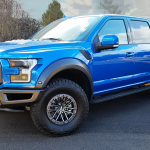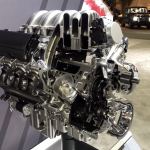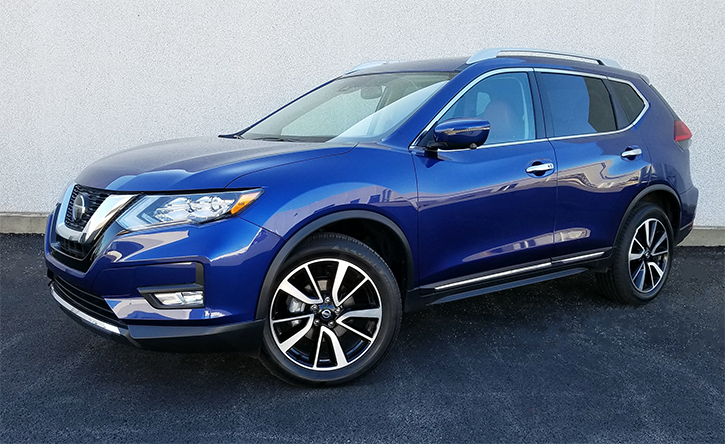
2019 Nissan Rogue SL AWD
Class: Compact Crossover
Miles Driven: 276
Fuel Used: 12.9 gallons
| CG Report Card | |
|---|---|
| Room and Comfort | B+ |
| Power and Performance | B- |
| Fit and Finish | B+ |
| Fuel Economy | B- |
| Value | B |
| Report-card grades are derived from a consensus of test-driver evaluations. All grades are versus other vehicles in the same class. Value grade is for specific trim level evaluated, and may not reflect Consumer Guide's impressions of the entire model lineup. | |
| Big & Tall Comfort | |
| Big Guy | B |
| Tall Guy | A |
| Big & Tall comfort ratings are for front seats only. "Big" rating based on male tester weighing approximately 350 pounds, "Tall" rating based on 6'6"-tall male tester. | |
| Drivetrain | |
| Engine Specs | 170-hp 2.5L |
| Engine Type | 4-cyl |
| Transmission | CVT automatic |
| Drive Wheels | AWD |
Real-world fuel economy: 21.4 mpg
Driving mix: 70% city, 30% highway
EPA-estimated fuel economy: 25/32/27 (city/highway/combined)
Fuel type: Regular gasoline
Base price: $32,740 (not including $995 destination charge)
Options on test car: Premium Package ($1820), Platinum Reserve Interior ($250), floor mats with cargo-area protector and first-aid kit ($280)
Price as tested: $36,085
Quick Hits
The great: Versatile passenger and cargo room in a smartly sized package; some innovative tech features; straightforward control layout
The good: Pleasant driving personality
The not so good: Engine can grow noisy when accelerating
More Rogue price and availability information
CG Says:
Your pals here at Consumer Guide have a history of going Rogue. Indeed, just in the period since Nissan gave its compact sport-utility vehicle a thorough freshening and upgrading for 2017, we’ve now driven four of them. Our latest, a top-of-the-line SL, follows a 2019 SV, ’18 SL, and ’17 SL Hybrid.
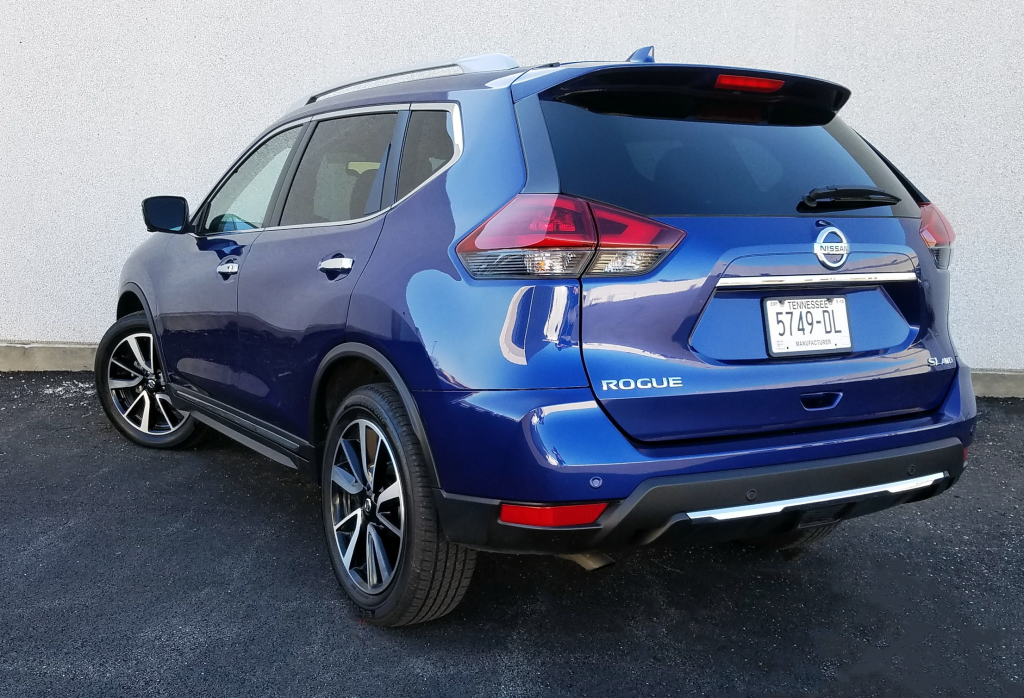
Each of these little test trucks has been endowed with all-wheel drive, and all but the Hybrid have run with the same powerteam—a 170-horsepower 2.5-liter 4-cylinder engine managed by a continuously variable transmission (CVT). Thus, the driving experience—in terms of engine performance, ride, handling, and interior accommodation—has been documented.
Furthermore, all of these recent Rogues are CG “Best Buy” picks for their respective model years. The Rogue is a vehicle that we like for its respectable fuel economy, impressive interior materials, and standout passenger and cargo versatility for the class.
More Nissan Rogue news and reviews
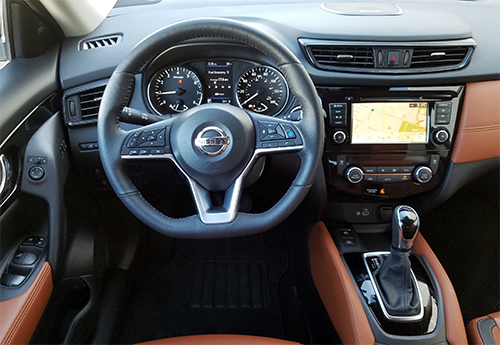
This latest example came in at $36,085 with delivery and options that included the Premium Package with LED headlights and power moonroof; Platinum Reserve interior with tan leather seats, quilted seat inserts, and piano-black door finishers; carpeted floor mats; cargo-area protector; and first-aid kit. The Platinum Reserve touches improve upon the leather upholstery and specific metallic door finishers that are standard features of the SL. Other standard equipment that separates the SL from the 2019 SV tested earlier comes down to 19-inch wheels, fog lights, Bose 9-speaker audio system, navigation, voice recognition for navigation and audio, NissanConnect Apps, SiriusXM Traffic and Travel Link, 360-degree exterior monitor, Homelink universal transceiver, Intelligent Cruise Control, ProPilot Assist, electronic parking brake, auto-dimming rearview mirror, memory driver’s seat and mirror settings, 4-way power-adjustable passenger seat, and heated steering wheel.
ProPilot is a new standard feature at the SL level. This “semi-autonomous” driving assist, which made its debut in 2018, pairs adaptive cruise control and automatic lane centering to take full management of spacing and steering from the driver’s control under certain conditions—though the driver’s hands must remain in contact with the steering wheel. Rear obstacle detection and rear automatic braking are now built in to SV and SL models, and all Rogues get a new Rear Door Alert that reminds occupants to check for items—or people!—that may be in the rear seat.
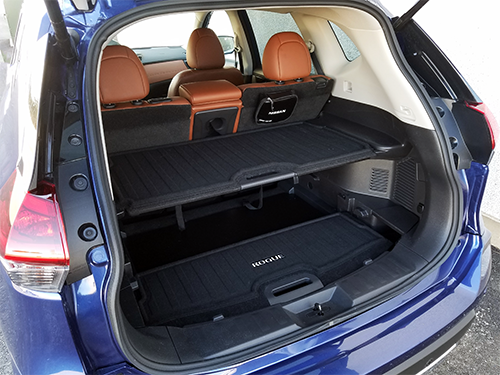
While we’ve been satisfied with the fuel mileage derived from other Rogues sampled by CG in recent years, the ’19 SL underperformed in this area. Our accumulated average after 276 city-weighted test miles came to 21.43 mpg, which is more than 3.5 mpg below the EPA projection in city driving. In general, powertrain performance is a mixed bag. Passing power strikes us as fairly average, and the engine makes some noise during acceleration, but the CVT behaves a little better than some of its ilk do in other vehicles.
Easy handling and a generally comfortable ride make the Rogue more agreeable to live with. One of its real strengths is a rear cargo area ingeniously configured for versatility and functional design. In 2018 Rogue surrendered its marginally useful third-row seating option, so all models now have the “Divide-N-Hide” cargo system. Its movable floor panels can be inserted at different heights to reconfigure the fairly ample cargo hold, create hidden storage spaces, or form a confined area to prevent small items from rattling around the full expanse of the load floor. Second-row seat backs are split 60/40. When retracted they don’t rest fully flat, but a flipper panel forms an uninterrupted platform with the rest of the cargo floor.
The Rogue does make good use of the two rows of seats that it does have—thanks to a very low driveline tunnel three adults can squeeze across the rear seat for full 5-passenger accommodation. Headroom is good, even under the panoramic sunroof. There’s pretty good personal-item storage in the cabin; large, legible gauges and displays inform the driver; and climate and audio systems are directly and intuitively operated.
For a lot of reasons that have to do with the day-in/day-out utility and convenience that crossover-SUV buyers seek, Nissan has made its Rogue the way to go.
Future Car: 2021 Chevrolet Trailblazer
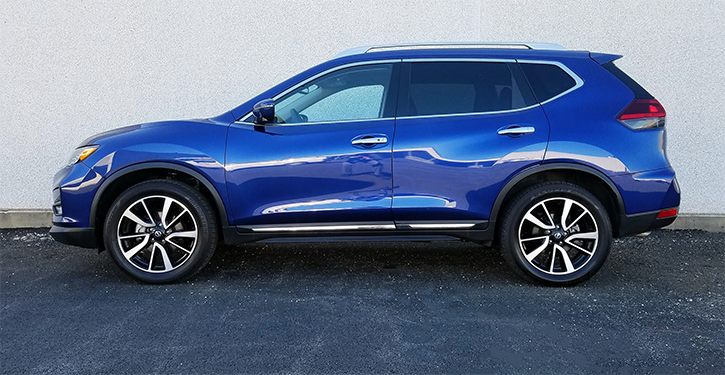
Test Drive: 2019 Mazda CX-5 Signature
2019 Nissan Rogue SL


